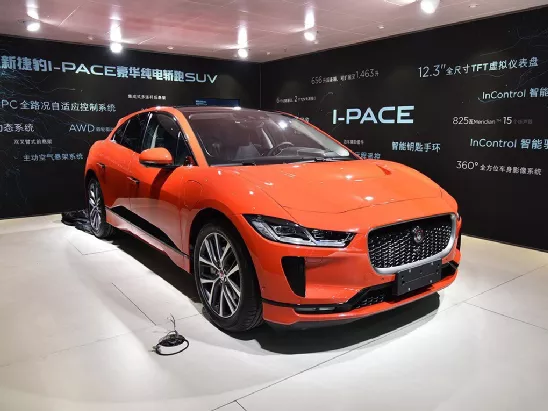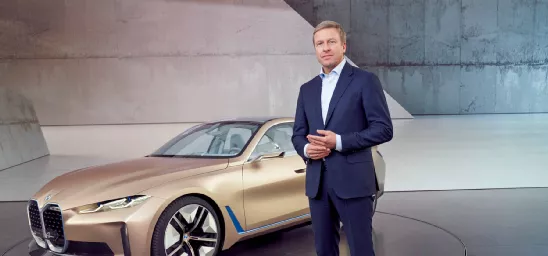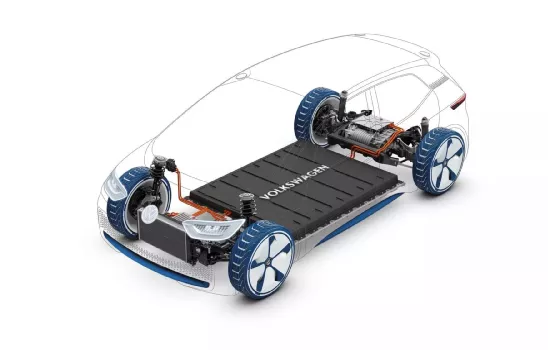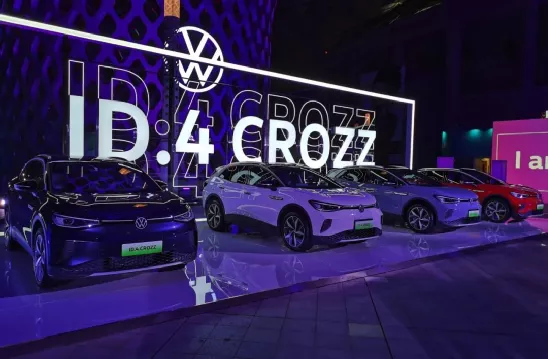An Introduction to Outing, a Media Under the Bai Ren Hui, Focusing on the Evolution of the Automotive Industry Chain
Author: Roomy
“When it comes to the ID.4, it looks too much like a Volkswagen”…
When Volkswagen released the highly anticipated ID.4 to the market, they did not expect it to be criticized for looking too much like a typical Volkswagen instead of being a complete revolution.
Similar to how the Chinese market responded to the BMW iX3 with “It’s just a BMW with a big nose”, the lack of novelty caused the specially crafted car to be priced too high and BMW’s new energy strategy to fail after a decade.
At the CES exhibition two years ago, before the official release of Mercedes-Benz EQC in China, I asked the head of global markets at Mercedes-Benz Germany, “Jaguar I-PACE is also a luxury electric car that required a lot of effort, but it has not been popular in China. Has Mercedes-Benz addressed this?”

At the time, the path to intelligent transformation was still uncertain with no way to know which direction and models were most appropriate. As a leader in the industry, these luxury brands still believe that they can dominate despite the absence of clear rules.
The answer provided was “Mercedes-Benz has a 130-year history of building cars, with a unique understanding of luxury and electricity. Mercedes-Benz electric vehicles are different from those of other brands.”
Even today, the transformation process has been more difficult than expected for these brands. Mercedes-Benz, like Jaguar Land Rover, recognized that conventional methods for fuel vehicles are less effective in the era of intelligence technology.
When the domestically produced Mercedes-Benz EQC was introduced to the market, there were less than 200 sales in the first month. Later, I conducted a survey where a 4S store salesperson mentioned that each store has sales goals for EQC but the customer inquiries were few and must be sold with combustion-powered cars.
There’s some truth to what a young Tesla owner that has been driving combustion-powered vehicles for over a decade said, “When young people choose electric cars, they don’t look at traditional brands, which is quite influential. If someone like me, a genuine German fanatic and loyal brand supporter, is switching to an electric car and ignoring traditional car manufacturers, that’s terrifying.”
A 93-year-old Lexus ES owner went from “hybrid is sufficient” to “buying a NIO ES6 is also an option”. This transition occurred quickly because “ABB making electric cars is still ABB; it’s not enough with technology and the future.”# Chinese Car Consumers’ Thoughts on Electric Cars
When intelligence and electrification were bundled together by internet car manufacturers, traditional car companies’ transformation was always destined to be fraught with difficulty.
In contrast to North America and Europe, wherein electric car ownership is commonplace, major Chinese automakers need to reassess the electric car consumer in China.
“The first thing a consumer wants to buy is my brand, and then my electric car,” this way of thinking has been phased out by strong winds of change.
When it comes to Europe, where Volkswagen is a trusted name in car manufacturing thanks to mature car-making technology, the decision to choose an ID model is an easy one. The Chinese consumer, on the other hand, considers “who or what technology” they will buy an electric car from.
Inadequate Transformation Awareness is a Form of Underestimation
Why are Chinese consumers reluctant to buy electric cars produced by traditional car companies, despite the significant effort and expense invested in them? This is a question being posed by Mercedes, BMW, Porsche, and Bentley.
Regardless of whether luxury brands are willing to accept the facts, the biggest challenge for them during the electrification era is being compelled to become “followers” in the transformation, after previously being accustomed to leading the technology and rule-making in the internal combustion engine era.
Audi serves as Volkswagen Group’s “brain” for technology, playing a crucial role in the transformation of the entire group. Volkswagen Group selected Audi’s global headquarters as the core organization for its automotive software R&D department, and has subsequently combined the roles of Volkswagen Group’s R&D director and Audi’s CEO. This aims to highlight Audi’s pivotal role in the group’s “research and development.”
Furthermore, Audi has invested in the electrification sector for a considerable period. However, in the Chinese market, Audi, which has been firmly on top of the luxury car leaderboard for over 30 years, has never had an advantage in terms of first mover status in electrification.
On September 17th, 2018, Audi launched its first mass-produced electric vehicle model, the Audi e-tron, at The Craneway Pavilion in the San Francisco Bay Area. This location is just a few dozen kilometers away from Tesla’s “home.”
The intentions behind this move were obvious: Audi wanted to look down upon Tesla while simultaneously defeating them.
Less than two months later, Audi brought the e-tron to the Chinese market. At that time, the car was positioned as having “filled the void in the luxury electric SUV market,” meaning consumers could now think of other high-end luxury electric SUVs besides just Tesla.At that time, the industry evaluation given to the Mercedes-Benz EQC was “like an unattractive Mercedes-Benz car” and the car was considered “first Audi, then e-tron”. However, it can be understood that the Audi brand’s electric signal model is still very “Audi”.
Luxury brands looked at Musk and traditional automakers tearing each other apart on Twitter and at Tesla’s loud slogans, but when they were losing money year after year, they may not have thought that Tesla would become the disruptor in this revolutionary change.
Two years ago, when luxury brands were interpreting the trend of electrification, they said, “The essence of fuel-powered cars and electric-powered cars are both cars; the difference is only in the power system.” They were still thinking that they could compete with Tesla, and said, “You go towards technology, and I have luxury”.
On the power platform, the e-tron is based on Audi’s existing MLB platform, and Mercedes-Benz claims that the EQC is based on an electrification platform, but it is actually derived from the MRA fuel platform with minor modifications. BMW, which once had an advantage in launching, announced that it would not develop an electrification platform and would only focus on scalable architecture compatible with both fuel and electric vehicles.
Assuming that the difference is really only the power system, then shouldn’t Tesla have been defeated after the luxury brands launched their electric cars? But in fact, Tesla still maintains a significant lead.
The seemingly “normal” EQC and e-tron have sales hovering around a few hundred vehicles. At the same time as the Mercedes-Benz EQC entered the Chinese market, the Tesla Model 3, which was launched earlier, and the NIO ES6, both had sales ranking in the market.
The BMW iX3, priced at 500,000 RMB, was officially reduced by 70,000 RMB for the entire series after its launch for more than two months, and discounts of 40,000-60,000 RMB were offered. Some could even be obtained for as low as 280,000 RMB.
Even with a 70,000 RMB discount, it still couldn’t sell. It can’t help but make people sigh. BMW, who had the goal of “establishing the rules,” once invested in the development of the i3 regardless of cost seven or eight years ago. Today, even the veteran in the pure electric field, the i3 born in 2013, is almost finished.
Looking back, will BMW regret it?
When the i3 and i8 were launched, BMW was once inclined to create a exclusive platform, just because the electrification trend was unclear, and they couldn’t judge which would be more popular in ten years: fuel-powered cars or electric cars. In order to ensure profitability, BMW slowed down its exploration of electrification and became conservative.As the first company to launch an electric vehicle model, Jaguar may have faced some difficulties. At the time when the I-PACE was introduced, battery technology and electronic architecture were expensive, creating a price barrier that prevented the luxury brand EV from being more popular. Moreover, for ultra-luxury brands, the transition to electric vehicles presents a greater challenge, as pure electric technology cannot yet meet the performance requirements of supercars. Lamborghini Asia Pacific’s Head repeatedly emphasized the “brand DNA” that makes supercars unique. McLaren CEO, Fu Lunyi, also openly admitted that they will not consider launching pure electric supercars in the short term. In addition, the transition to electric vehicles requires a large investment in funds, platforms, and research and development, which becomes a limiting factor for ultra-luxury car brands.
Of course, the platform alone cannot determine the overall strength of an EV product, but it can play a key role. That’s also why I believe that “ABB making EVs may be insufficient due to technology reasons.” Facing the demand for autonomous driving systems, traditional electronic and electrical architecture is eventually limited, and the 100 ECUs that are commonly seen in traditional cars are becoming insufficient. Rapid electrification requires more changes to the electronic architecture of cars.
It can be said that the inability to fully understand the transformation is a kind of underestimation. Research has shown that many luxury car owners have switched to Tesla, leading to a 30% decline in residual value for traditional luxury cars, while the Model 3 has a residual value of up to 90% after three years of use.
Regardless of whether we are willing to admit it, in the era of electric cars, traditional luxury car brands have fallen behind Tesla. Struggling and suffering have become the norm in the era of transformation.
For traditional luxury car brands, there is one group of data that is particularly worrisome. Recently, across Europe, Tesla is the most searched luxury car brand, followed by BMW and Audi. Mercedes-Benz has fallen out of the top three, which is not a normal change but indicates that consumers are shifting from “luxury” to “technology”.
According to a study by the US auto finance company, Capital One, with the rise of Tesla, consumers’ perception of “luxury” has shifted, and “technology” has become a key factor rather than “craftsmanship” or “configuration.” Tesla has made it difficult for traditional luxury car brands by blurring the definition of a luxury EV.This change also illustrates a cruel fact. In the era of electric vehicles, the gold-lettered brands xDrive, 4MATIC, quattro, and other proud technological barriers no longer exist.
Luxury brands, who have been elegant for half a century, have finally made up their minds to change, seeing the game rules being firmly controlled by a young and inexperienced person.
Mercedes-Benz obviously does not want to be replaced by a young person from Silicon Valley after occupying a steady position for more than 130 years. Therefore, they are resolutely making efforts on the platform.
Currently, the Mercedes-Benz EQ series has electric platforms such as MAR, MFA II, EVA, and MMA. MAR is a research and development platform for fuel vehicles, while EVA is a research and development platform for electric modularization. The more technologically advanced Mercedes-Benz EQS is developed based on the EVA platform. In terms of technology, Mercedes-Benz is developing the on-board intelligent system MB.OS in collaboration with Nvidia, which is expected to be launched in 2024.
At the Shanghai Auto Show this year, Mercedes-Benz came prepared, and for the first time, there was no trace of fuel vehicles during the “EQ Night.” They realized that “they still have a long way to go” due to the market twists and turns of the EQC over the past two years. Lin Song, the CEO of Mercedes-Benz, also confirmed that multiple models will achieve electrification transformations. Meanwhile, they are also striving to enhance the voice in the field of power batteries.
Now, there are also different opinions within BMW.
The chairman of the BMW labor union stated clearly in an interview that BMW should change its course and establish a dedicated pure electric platform. The products produced on compatible platforms are not competitive enough. He even actively advocated directly launching pure electric versions of 3, 5, and 7 Series, rather than plug-in hybrid versions, otherwise, they will lag behind competitors.
The first electric car of BMW had poor sales because it was not a pure electric vehicle product but a “fuel-to-electric” model based on the X3 fuel vehicle. It was a transitional product for transformation with poor sales, which also shows the necessity for a dedicated platform.
However, the chairman’s plea did not receive the approval of BMW’s leader Zipse. He believes that consumers do not care whether a car comes from an exclusive platform or not. Perhaps this view may be feasible in the European market, but it is difficult to say in the current Chinese market, where there is a consumer atmosphere emphasizing technology.
Even though there is a difference in opinions, BMW is still accelerating. The pure electric flagship SUV BMW iX and BMW i4 will enter the domestic market. Audi has the fastest transformation speed among the three, and the two products, e-tron GT and RS e-tron GT, which focus on performance and technology, will be launched later this year.
However, I think the Lexus owner born in 1993 believes that ABB is not techy enough and too conservative, which may also represent the view of some young Chinese consumers on electric vehicles. “Why should I buy an electric car that looks similar to a fuel car?”
Moreover, there is a data point that Qi Zhi Ce can take a look at. When consumers choose an electric car brand, there is no longer “brand loyalty”, and they may only choose from 1-2 brands. Choosing XiaoPeng, choosing Tesla, may all be due to a certain technology, a certain person.
Volkswagen, another German giant, disagrees with Qi Zhi Ce’s statement.
Diess believes that the difference between products built on different platforms is still quite significant. This is also the reason why Volkswagen insists on building exclusive platforms and developing software architectures.

This point can be seen from the ID series. From appearance to interior design, it is all brand new. The intention of the “New Volkswagen” is also here. Porsche and Bentley’s transformation is faster than other ultra-luxury brands, also because they are under the Volkswagen Group.
The models born on the brand new MEB platform developed by Volkswagen, from ID.3 to ID.4, have been popular in Europe. The technology and quality of the ID series can be said to be based in Europe, covering economy, safety, and stability comprehensively.
As for why the sales of the ID series in China did not meet expectations, this can be attributed to whether Germans understand the level of dependence on intelligentization and usage habits of Chinese consumers. Everyone who test drove the ID.4 model gave the same feedback, “the car’s system is just not good enough.”
From Tesla to NIO and XPeng, the entire process of these new car brands entering the consumer’s field of vision is deeply tied to electrification and intelligentization. It can be said that the transformation of automotive software and hardware system architecture is evolving towards the direction set by Tesla.
The speed of OTA upgrades, the number of radars, and the level of intelligence have also become an unwritten rule.
Tesla knows it, and the new automakers who shouted “catching up with and surpassing Tesla” also know it. Volkswagen, however, does not understand as much, and has suffered from “not adapting to the local environment.”

I remember at a technology sharing conference, Volkswagen’s technical engineer also said, “Chinese consumers need to get used to the bottom logic and hierarchical pages of the ID.4.”Not actively targeting the young generation who has grown up from the era of the Internet in China, this inevitably means that even the ID.4, which has no weaknesses in terms of range, handling, experience, and performance, will not be regarded as a brand new electric vehicle in the eyes and minds of young people.
Naturally, it is also unable to enter the view of middle-aged people like my colleague who switched from German cars to Tesla.
As for a young person born in 1996 and fond of NIO, he couldn’t find any highlights in dozens of PPT introductions at the ID.6 technology sharing event. The monotonous and direct infusion of technical knowledge attempted to make him feel a bit bored. “Traditional car companies that used to dance with long sleeves in marketing now don’t know how to explain things.”
This is not just a problem for Volkswagen, but a challenge for all traditional car companies, including Mercedes-Benz and BMW, on how to more effectively disseminate new technologies and interpret new stories.
One commendable point is that shortly after being criticized for the car’s infotainment system, the Volkswagen ID. series released its first OTA upgrade and will be updated every 12 weeks in the future, although it is not particularly fast.
This is a good signal and also a lesson that is enough to make those luxury brands who have not yet put down their dignity to be vigilant.
This article is a translation by ChatGPT of a Chinese report from 42HOW. If you have any questions about it, please email bd@42how.com.